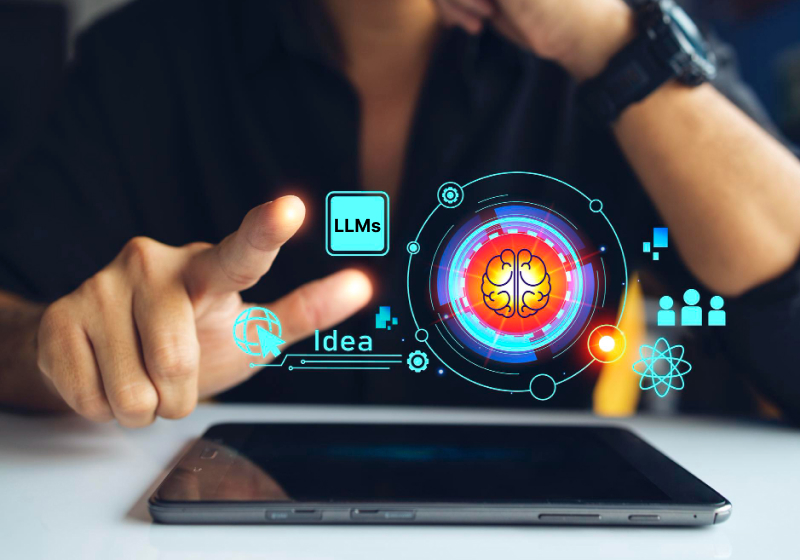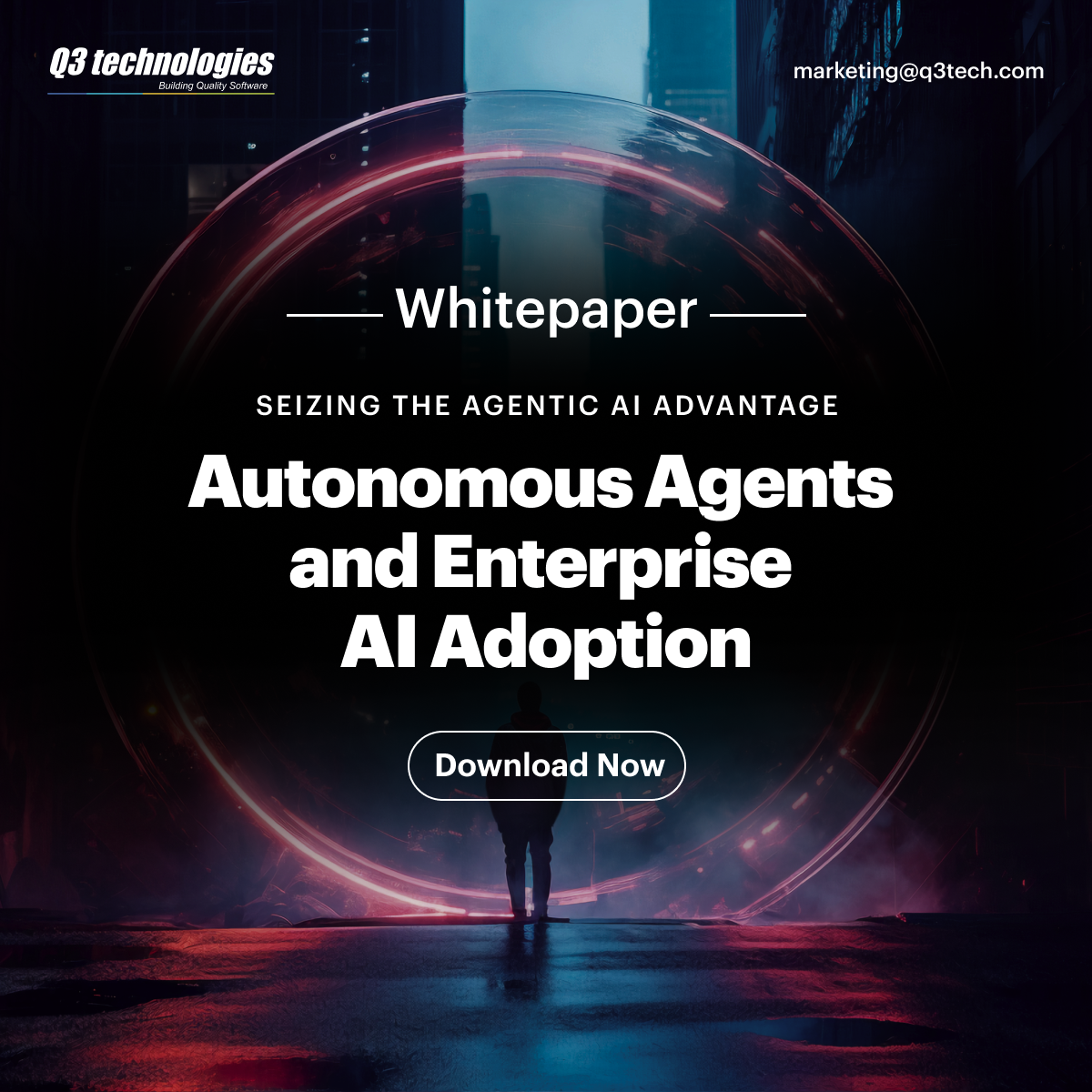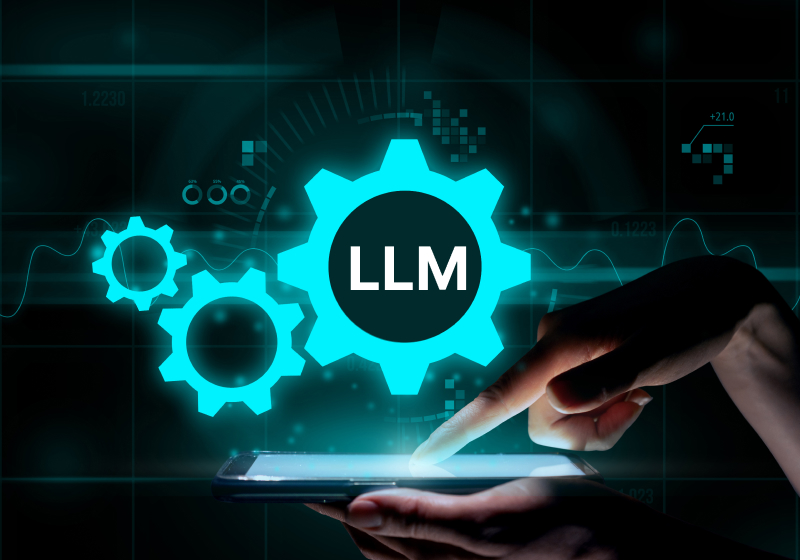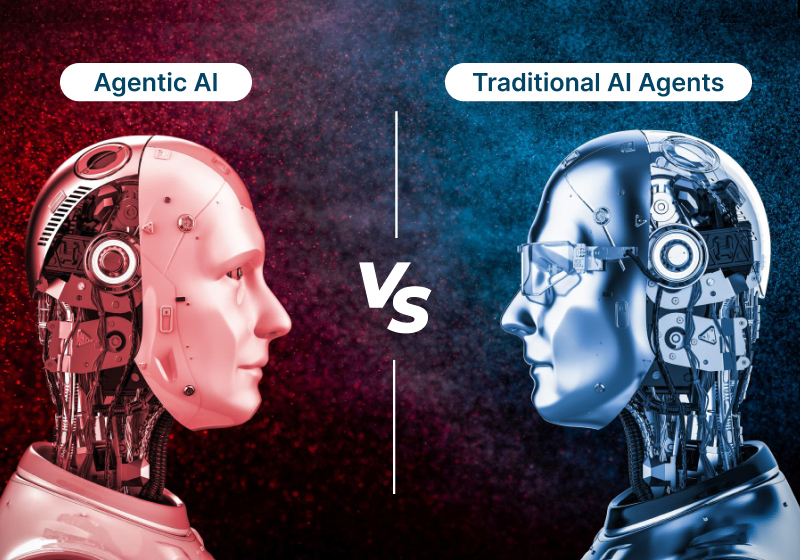LLM
How are Multi-Modal LLMs Changing AI’s Role in Industry Innovation?
 Updated 12 Jun 2025
Updated 12 Jun 2025

Artificial Intelligence (AI) has undergone dramatic changes in recent years. Among its most exciting developments is the emergence of multimodal LLMs, which integrate multiple data types such as text, images, audio, and even sensory signals. According to a recent report by Grand View Research, the global AI market is expected to reach USD 1,811.8 billion by 2030, growing at a CAGR of 37.3% from 2023 to 2030. This explosive growth is being driven by technological innovations, with multimodal LLMs taking the centre stage in shaping AI in industry innovation.
Another report from McKinsey & Company highlights that companies leveraging advanced AI models, especially multimodal systems, experience a 15–20% increase in operational efficiency and innovation rate. These insights highlight a powerful truth—AI is no longer confined to analysing text; it is now becoming an all-encompassing tool, revolutionising diverse sectors through multimodal AI applications.
From Text-Only Models to Multimodal Capabilities
The first wave of LLMs, like GPT and BERT, focused heavily on text. They were great at generating coherent text and understanding language semantics. However, the modern world is multimodal. We consume and create data in various formats—Instagram images, YouTube videos, podcasts, and sensor outputs.
The evolution to multimodal LLMs is a natural progression. Now, models can simultaneously process a patient’s X-ray (visual), spoken symptoms (audio), and medical history (text) to provide a comprehensive diagnosis—a leap forward in sectors like healthcare and AI-driven solution development.
The Need for Richer Data Understanding in AI
In most business contexts, data isn’t just text—it’s product images, customer reviews, voice commands, real-time sensor readings, and more. Traditional AI models were ill-equipped to synthesise such diverse data. This gap led to the rise of multimodal LLMs, which offer holistic interpretation.
For instance, AI Development Companies now use these models in Chatbot Development Services to create bots that understand and respond to text and voice, analyze customer mood via images, and guide them with real-time, context-aware suggestions. This level of richness opens up countless possibilities in the Future of AI in business.
Unlock Industry Innovation with Multimodal LLMs
Leverage our AI expertise to build intelligent, cross-format solutions.
How They Differ from Traditional LLMs
While traditional LLMs are trained solely on language-based corpora, multimodal LLMs are trained on a diverse dataset of images, text, audio, and even touch or sensor data. They also utilize cross-attention mechanisms to align these varied inputs.
As a result, multimodal LLMs can:
- Understand context from multiple formats: These models can piece together clues from different input types, giving them a deeper understanding and relevance.
- Deliver more accurate predictions: They make informed decisions using broader data inputs, reducing error and uncertainty.
- Offer improved user interactions: Conversations and actions by these models feel more natural and personalized due to the variety of data they process.
- Unlock new levels of automation and intelligence: They can perform complex tasks that previously required human-level interpretation, like analyzing video and responding in context.
Real-World Analogy for Easy Comprehension
Imagine teaching a child to identify an apple. You show them the fruit (visual), let them touch it (sensor), smell it (olfactory), and say the word “apple” (audio). This multi-sensory learning experience helps the child understand the apple better than just reading about it. Similarly, multimodal LLMs “learn” in a comprehensive way, resulting in deeper and more accurate outputs.
Integration of Modalities
- Visual Modality: Enables AI to analyze and interpret images and videos. It helps in applications like facial recognition, product search, and medical imaging.
- Auditory Modality: Powers voice recognition and sentiment analysis in call centres, smart assistants, and virtual healthcare monitoring.
- Linguistic Modality: The foundation of traditional LLMs, this is crucial for understanding, generating, and translating text across applications like chatbots and content automation.
- Other Modalities (Sensors, Touch, etc.): Involves non-traditional inputs such as motion, temperature, and tactile feedback used in wearables, robotics, and IoT devices.
Advances in Neural Networks and Machine Learning
- Transfer Learning Techniques: These allow models trained on one task or modality to be fine-tuned for another, saving resources and improving performance across domains.
- Attention Mechanisms: Mechanisms like transformers help the model focus on important data, improving context awareness and reducing irrelevant noise.
- Scaling Architectures: Advancements in model design now support massive training on multimodal data or light-weight versions for mobile and edge devices.
Need a Custom Multi-Modal AI Model?
We help businesses of all sizes deploy scalable, secure, high-performing LLMs.
Top 15 Industry Applications of Multimodal LLMs
- E-commerce: Visual search allows customers to upload product images to find similar items; sentiment analysis tracks reviews and customer reactions.
- Healthcare: Models analyze medical scans, patient records, and voice notes to assist in diagnostics and personalized treatment planning.
- Education: Supports interactive learning using video, speech recognition, and natural language generation for automated assessments.
- Autonomous Vehicles: Uses visual (camera), auditory (road noise), and sensor (radar/LiDAR) inputs for real-time driving decisions.
- Finance: Assesses voice and text from customer service, fraud detection via transaction pattern and image-based document verification.
- Travel: AI travel guides integrate voice commands, location visuals, and translated text to enhance traveller experiences.
- Media & Entertainment: Recommends content using viewing patterns, voice search, and personalized content creation.
- Retail: In-store analytics based on video surveillance, audio inputs, and inventory sensors optimize merchandising and stock.
- Manufacturing: Uses multimodal data like video feeds, pressure sensors, and audio signals for predictive maintenance.
- Agriculture: Combines soil sensor data, weather reports, and drone imagery to optimize crop health and yield predictions.
- Smart Cities: Integrates video surveillance, traffic sound, and real-time data from smart infrastructure to manage urban systems.
- Legal: Analyzes court footage, transcripts, and case laws using multimodal tools for efficient research and summaries.
- HR & Recruitment: Enhances resume screening with video interview analysis and sentiment detection during hiring processes.
- Logistics: AI models analyze cargo images, barcode scans, and real-time location data to streamline shipping and delivery.
- Customer Support: Multimodal chatbots understand voice, facial expression, and written queries for responsive service.
Benefits of Multimodal LLMs Over Unimodal Systems
- Enhanced accuracy and contextual understanding: Multimodal inputs reduce ambiguity and provide more nuanced decision-making.
- Human-like interactions: These models understand and replicate natural communication patterns for better engagement.
- Better decision-making in dynamic environments: They handle complex scenarios where information comes from varied sources.
- Improved user satisfaction and personalization: Combining modalities ensures relevant, tailored responses.
- Versatility across industries: They fit into diverse applications from robotics to education seamlessly.
- Enable AI-powered multimodal language consulting: Help businesses align their unique data with suitable AI strategies.
Challenges of Using Multi-Modal AI
- High computational requirements: Training and inference on multimodal data require significant hardware and energy.
- Data alignment and synchronization complexity: Synchronizing audio, video, and text data is technically challenging.
- Model interpretability and debugging difficulty: It’s harder to pinpoint errors or explain decisions in complex models.
- Need for vast, annotated multimodal datasets: Requires comprehensive, well-labeled datasets which are expensive and time-consuming.
- Ethical concerns in data collection and privacy: Using visual or voice data must comply with strict consent and privacy laws.
Open Source & Small-Scale Models
There’s a growing movement toward open source multimodal LLM tools and small multimodal LLM versions that can run efficiently on limited hardware. Models like Flamingo, BLIP-2, and MiniGPT-4 exemplify this shift.
These tools are particularly helpful for startups, educational institutions, and niche enterprises looking to test multimodal project ideas without investing in massive infrastructure.
Some Examples of Multimodal LLMs
GPT-4o (OpenAI): Accepts and understands text, images, and speech, delivering strong performance across tasks.
Gemini (Google DeepMind): Excels at connecting text and image for content generation, search, and document parsing.
CLIP (OpenAI): Matches text descriptions to images with high accuracy, used in search and classification.
Flamingo (DeepMind): Performs few-shot learning in multimodal tasks, requiring minimal training examples.
BLIP-2 (Salesforce): Efficient model for bridging image understanding and language tasks.
The Role of AI-Powered Multimodal Language Consulting
AI-powered multimodal language consulting is helping businesses strategize their AI adoption by aligning it with domain-specific requirements. Consultants assess organizational data types and recommend suitable multimodal LLMs that improve operational workflows and innovation.
Solution architecture: Designing tailored systems that integrate various modalities effectively.
Model selection: Identifying the best-fit models based on data, use case, and budget.
Use case identification: Helping pinpoint real business problems where multimodal AI can deliver value.
ROI tracking: Measuring outcomes to assess productivity, cost-efficiency, and innovation boosts.
How to Choose the Right Multi-Modal Model for Your Industry
- Identify Data Types: Determine whether your data includes images, text, voice, video, or sensor inputs. This helps shortlist suitable model types.
- Define Objectives: Set clear goals such as automation, prediction, personalization, or data analysis to find the most aligned model.
- Evaluate Infrastructure: Assess whether you have the computing power to handle large models or need lighter, small multimodal LLMs.
- Check Community Support: Open-source models may offer active forums and toolkits, reducing development costs and time.
- Consider Scalability: Make sure your chosen solution can expand with business growth and support future upgrades.
Ethical Considerations and Responsible AI Development
Bias in multimodal data: Ensure fairness by using diverse datasets and regularly auditing outputs for discrimination.
User consent for audio/image usage: Be transparent about data use and obtain clear consent from users.
Model hallucinations: Implement guardrails to minimize inaccuracies or fabricated outputs.
Transparent model decisions: Use explainable AI tools to clarify how models make decisions to ensure accountability.
How Q3 Technologies Empowers Businesses with Multimodal LLM Solutions
Q3 Technologies is at the forefront of AI innovation by developing next-gen multimodal LLM solutions tailored to industry needs. We help businesses integrate text, image, audio, and sensor data into intelligent workflows. Our experts design scalable AI architectures that enhance automation and decision-making. With strong capabilities in AI-powered multimodal language consulting, we ensure high-impact, domain-specific implementations. From strategy to deployment, Q3 Technologies empowers clients to harness the full potential of multimodal AI.
Conclusion & Strategic Roadmap for Businesses
The age of multimodal LLMs is here, and it’s changing the Role of LLMs in innovation. By unifying diverse data streams, these models empower companies to make smarter decisions, deliver superior customer experiences, and unlock new avenues of growth.
To remain competitive, businesses should:
- Start small with multimodal project ideas: Begin with pilot projects that explore quick wins and ROI-focused outcomes.
- Explore open-source multimodal LLM tools: Test capabilities before committing to larger investments.
- Partner with an expert LLM Development Company: Leverage their expertise for custom solutions and best practices.
- Invest in AI-powered multimodal language consulting: Develop a long-term AI roadmap aligned with business goals.
By taking these steps, organizations can embrace the Future of AI in business and ride the next wave of AI in industry innovation with confidence and clarity.
FAQs
What is a multi-modal LLM, and how does it work?
A multi-modal LLM is an advanced AI model that understands and processes multiple data types, such as text, images, audio, and video, together. This allows for more intelligent, real-world applications.
How are multi-modal LLMs different from traditional LLMs?
Traditional LLMs process only text, while multimodal LLMs can handle multiple formats simultaneously, enabling deeper and more human-like understanding.
What are the benefits of multimodal LLMs in business?
Benefits of LLMs in business include faster insights, enhanced automation, smarter decision-making, better personalization, and improved customer experiences.
Are there open-source or small multimodal LLMs available?
Yes, there are several open-source multimodal LLM options such as MiniGPT-4 and LLaVA, which are ideal for startups and small businesses.
What industries are currently using multimodal LLMs?
Industries like healthcare, education, retail, and manufacturing are using multimodal LLMs for diagnosis, customer support, product search, learning tools, and predictive maintenance.
How can Q3 Technologies help implement multimodal AI solutions?
Q3 Technologies provides AI-powered multimodal language consulting, custom LLM development, and integration services tailored to your industry needs and business goals.
Table of Content
- From Text-Only Models to Multimodal Capabilities
- The Need for Richer Data Understanding in AI
- How They Differ from Traditional LLMs
- Real-World Analogy for Easy Comprehension
- Integration of Modalities
- Advances in Neural Networks and Machine Learning
- Top 15 Industry Applications of Multimodal LLMs
- Benefits of Multimodal LLMs Over Unimodal Systems
- Challenges of Using Multi-Modal AI
- Open Source & Small-Scale Models
- Some Examples of Multimodal LLMs
- The Role of AI-Powered Multimodal Language Consulting
- How to Choose the Right Multi-Modal Model for Your Industry
- Ethical Considerations and Responsible AI Development
- How Q3 Technologies Empowers Businesses with Multimodal LLM Solutions
- FAQs



